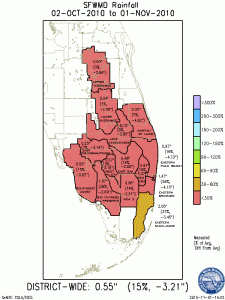South Florida Experiences Driest October on Record
 With little rainfall in recent weeks, meteorologists from the South Florida Water Management District (SFWMD) reported that last month was the driest October in South Florida since recordkeeping began in 1932. The low monthly rainfall total, coupled with seasonal forecasts of exceptionally dry conditions, underscores the need for water conservation to protect the region’s limited water supply.
With little rainfall in recent weeks, meteorologists from the South Florida Water Management District (SFWMD) reported that last month was the driest October in South Florida since recordkeeping began in 1932. The low monthly rainfall total, coupled with seasonal forecasts of exceptionally dry conditions, underscores the need for water conservation to protect the region’s limited water supply.
“Given the below average rainfall during the wet season, the forecast for a drier-than-average dry season and the unpredictability of our weather means saving as much water as possible now is critical to South Florida,” said Tommy Strowd, SFWMD Deputy Executive Director of Operations and Maintenance.
For October, the District’s 16-county region received an average of 0.55 inches of rainfall. This represents 15 percent of the normal total for the month, or a deficit of 3.21 inches.
The Upper and Lower Kissimmee basins were hit hardest, registering less than 1 percent of average rainfall for a monthly deficit of more than 2.5 inches. In particular, Lake Istokpoga is heading toward water shortage conditions for water users in its immediate area. These conditions also threaten to create a potentially severe wildfire season, according to the Florida Department of Agriculture and Consumer Services.
Most areas along the east coast saw rainfall amounts of 7 to 37 percent of average for the month, creating rainfall deficits of more than 4 inches. Rainfall totals on the southwest coast were about 15 percent of average, or 3 inches below normal. Lake Okeechobee rainfall totaled 0.10 inches, or 3 percent of average rainfall. The lake level is 13.47 feet above sea level and continues to fall.
In mid-October, the National Weather Service declared an early start to the annual dry season and forecast the strongest La Niña for this time of year since 1955. La Niña is a weather phenomenon that creates colder than normal ocean surface temperatures in the equatorial Pacific, which drives dry weather into South Florida.
While about 12 inches of rain falls on average across the District’s 16-county region from November through March, La Niña-influenced dry seasons often produce only about two-thirds of the average during this five-month period.
Predictions of abnormally dry conditions for the coming months follow the driest wet season since 1984 in South Florida. An average of 27.31 inches of rain fell between June 1 and October 31, representing 82 percent of the normal amount and a deficit of 6 inches. This was also the hottest summer on record in Southeast Florida and the second hottest in Naples, according to the National Weather Service.
In fact, the National Oceanic and Atmospheric Association’s (NOAA) Climate Prediction Center is forecasting record La Niña conditions for each month from October to April, along with several related dry season predictions, including:
- 1 to 2 winter storms over Florida for the dry season, which is 4 to 5 below normal.
- La Niña pattern produces lower risk for tornadoes across the Florida peninsula compared with El Niño years.
- Latest long-range model projects a warmer-than-normal winter, though freezes are still a possibility.
- Average winter temperature predicted to be 64-66F interior/west to 67-69F east.
Weather Roller Coaster
Forecasts of a drier-than-normal dry season once again showcase South Florida’s weather extremes and water management challenges.
- Normal: Florida receives an average of 52 inches of rainfall a year, with 70 percent falling during the five-month wet season from approximately June through October.
- Drier than Normal: The 2010 wet season produced an approximately 6 inch deficit.
- Wetter than Normal: The 2009-2010 dry season recorded 131 percent of average dry season rainfall, representing 5.88 inches above normal from the beginning of November through the end of May.
- Record Wet Conditions: In 2009, the sea breeze cycle ushered in the wet season in May. With 9.04 inches of rain falling across the District, May 2009 became the wettest May on record, according to District records dating back to 1932.
- Drier than Normal: The 2008-2009 South Florida dry season was the third driest on record as of March 1, 2009.
- Record Dry Conditions: November 2008 through April 2009 marked the driest six-month period in South Florida, according to District records dating back to 1932.
Water Conservation Remains Key
The South Florida Water Management District’s Comprehensive Water Conservation Program was approved by the Governing Board in September 2008 to encourage more consistent use of water resources throughout South Florida. Numerous stakeholders worked with the District to define specific regulatory, voluntary and incentive-based programs and in-depth education and marketing plans that will help foster a year-round conservation ethic. The program includes Year-Round Landscape Irrigation Conservation Measures that took effect in March 2010.
The SFWMD continues to closely monitor water levels and is urging residents and businesses to conserve water and follow landscape irrigation restrictions in effect. More information about irrigation restrictions by area and water-saving tips are available at www.savewaterfl.com.
For more information:
- SFWMD Weather/Rainfall Data
- National Weather Service Dry Season Forecast
- Climate Prediction Center FAQ on La Niña
Climate Prediction Center Precipitation Forecast
Related posts:
- Wet January welcome but water shortage concerns remain
- Broward County faces possible tougher water restrictions
- Year round water conservation now a standard in South Florida
- SFWMD Extends Hydrologic Monitoring Agreements
- SFWMD urging conservation of water due to rainfall deficits
Short URL: https://browardnetonline.com/?p=10298




[...] South Florida experiences driest October on record (Bradenton Net Online) [...]